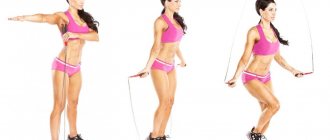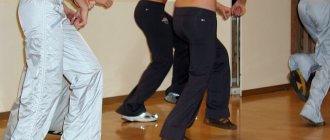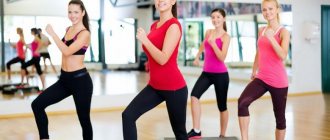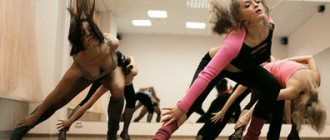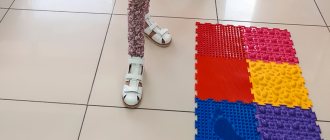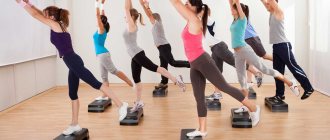This article is devoted to the study of the basic elements of classical aerobics. It describes the technique of performing basic steps (with counting), and also gives their English names, which are sometimes so difficult to hear from the lips of the coach. Once you have mastered the basic steps of aerobics, you can safely move on to more complex choreography.
More complex choreography is created from basic movements.
Classic aerobics - a brief history
The founder of classical aerobics is the American, Air Force Colonel and Doctor of Medical Sciences, Kenneth Cooper. It was he who first introduced the term “aerobics” in 1968 and published his first book of the same name.
Jane Fonda made aerobics popular.
The world owes the spread of the ideas of Dr. Cooper, who worked mainly for the US Air Force, to the Hollywood actress and fashion model Jane Fonda. In the late 70s, based on Cooper's books, she developed a system of aerobic exercises performed to rhythmic music. Having also published her findings, she released a number of videotapes with simple and understandable instructions for everyone.
Nowadays it is difficult to imagine a fitness club that would not offer at least 2-3 aerobic or “cardio” areas (basic aerobics, step aerobics, dance aerobics, aerobics with elements of kickboxing, etc.). All these directions were invented by processing and modifying the basic steps of classical aerobics.
Trekking
Trekking aerobics is a type of fitness that involves exercising on treadmills. Very suitable for running and walking enthusiasts. It prevents vascular diseases, stabilizes the functioning of the respiratory system, and normalizes sleep patterns.
The load on your legs is determined by a specialist depending on what exactly you want to do.
For beginners, training can last no more than 25-30 minutes to prepare muscle fibers for the next stages of training. For more advanced students, the lesson lasts 40-45 minutes.
Basic steps in classical aerobics
All steps in classical aerobics are performed to the beat of music on 2 or 4 counts. Links of steps in 8 (8 counts is a musical phrase), 16 or 32 counts (32 counts is a musical square). A professional trainer must pronounce the names of the steps out loud (give verbal commands), and also show some steps, their direction and number with gestures.
Basic movements in aerobics are the foundation for building more complex choreographic compositions. Aerobics can vary in the intensity of the exercises, as well as the impact on the joints.
Below I will provide descriptions of the classic basic aerobics steps. In fact, there are many more variations of steps, but, of course, to learn to read, you first need to learn the alphabet. If you're planning to attend an aerobics class for the first time, or simply want to better understand the basics, this guide is for you.
There are 2 types of steps in aerobics:
- Steps that do not change the leading foot. The leading leg is the one with which you begin the movement. No matter how many steps you take from this group, you will begin each next step on the same foot.
- Steps that change the foot. You will start each next step on the other foot.
All steps are performed in 2 or 4 counts (measures of music).
Tips for doing exercises
- Each lesson begins with a warm-up . It is better not to be late for class, because the better you warm up, the more effective the class will be and the less likely there will be injuries and sprains.
- When you just start training and just can’t get into the groove, don’t be upset - any normal aerobics trainer will always meet you halfway and stay after class to show you the most difficult exercises again.
- Regularity. Since you have seriously decided to get your figure in order, remember: regularity is a prerequisite . The option “I walk for a week, I’m lazy for two weeks” will not give any effect. To achieve results, you need to train at least 3 times a week for several months. After that, you can move on to a system of maintenance classes (2 times a week for 30-40 minutes).
- Gradual increase in loads. If you have not been involved in fitness before, it is better to start training with short-term sessions of 10-15 minutes , gradually increasing the duration to 30-40 minutes a day. For starters - aerobic exercises, after - exercise machines.
- No masochism! You should not torture yourself with unnecessary stress, especially in the first months of classes . Fatigue, of course, should be present, but if you exercise almost until you lose consciousness, and then do not find the strength to walk home, such training will do more harm than good.
- Make a study schedule for the month and a plan for each week . This will help you organize your life and allocate the time needed to visit the fitness center. Knowing in advance that you have training planned for this evening, you will be able to plan your time more correctly. And miss classes less often.
Steps without changing the leading foot
The number of accounts for which this step is performed is indicated in parentheses.
March (4)
This is a simple step on the spot. Performed on 4 counts.
- step with one foot in place
- step with the other foot in place
- step with the first foot in place
- step with the second foot in place
Mambo (4)
This step is a variation of the “march” step, with the leading foot first moving forward and then back.
- one step forward
- step with the second foot in place
- step back with the first foot
- step with the second foot in place
The mambo step can also be performed in a diagonal direction. In this case:
- step one forward diagonally (if we start to step with our right foot, we move it forward to the left, if with our left, we move it forward to the right)
- step with the second foot in place
- step back with the first leg (since on the first count we turned the body diagonally, we simply take this step back, it will automatically turn out diagonally)
- step with the second foot in place
V-step (4)
This step is named so because of the similarity of the pattern we walk on the floor with the Latin letter “V”.
- step one foot forward to the side (if we start with the right foot, we step forward to the right, if with the left, we step forward to the left)
- step the other foot forward in the other direction
- return the first leg to its place
- step the other foot into place
Cross (4)
This is the most difficult step for beginners without changing legs. It's called "cross" because it involves crossing your legs.
- one step forward crosswise (if we start to step with our right foot, we move it forward to the left, if with our left, we move it forward to the right, while the body looks straight, unlike the “mambo-diagonal” step, the legs turn out to be crossed)
- step with the second foot we step aside (right - to the right, left - to the left)
- return the first leg to the starting position
- place the second foot next to the first
Water aerobics
An unusual, but gentle on the spine type of exercise. Training is carried out in water.
Due to the aquatic environment, the load on the spine is reduced, while the muscle load increases due to overcoming the resistance of the water.
Thus, when performing water aerobics exercises, all muscles are trained at the same time, which increases their endurance faster than other types of training.
It is suitable for people of different weight and age categories, and even for pregnant women.
Steps with changing leading foot
Step-touch (2) *
This is a normal side step. Steps on two counts are usually (not always) made at least two at a time. Those. a step in one direction and a step in the other direction.
- step one foot to the side
- place the second leg next to the first (we start the next step with the same leg and step in the other direction)
We take the second step from the foot with which we finished the previous step.
Double Step-touch (2+2)
These are two side steps that are taken in the same direction (from one leg).
- step one foot to the side
- place the second leg next to the first
- another step with the first foot in the same direction
- place the second leg next to the first
Step-tap (2) *
This is the so-called step-touch.
- step one foot to the side
- touch the floor with the second foot in front of the first foot
Chasse (2)
Another option for the side step. This step has a so-called “broken” rhythm. You need to make three movements for two counts. One is one count, and “and-two” is the second count, for which you need to perform two faster movements.
- step one foot to the side
- place the second foot next to the first and take a step with the first foot in place
Step-lift (2) *
- front
- back
- side
A step in which a straight leg is extended in a certain direction (a leg swing is made).
- step one foot to the side
- swing the other leg in the desired direction (front - forward, side - to the side, back - back)
Step-kick (2) *
The name of the step is literally translated as “kick”.
- step one foot to the side
- bend the second leg forward at the knee in front of the first (make a kick)
Step-curl (2) *
This step is an overlap.
- step one foot to the side
- bend the second leg back at the knee (make an overlap)
Step-plie (2) *
In other words - squatting.
- step one foot to the side
- straighten the second leg without lifting it off the floor, and at the same time squat on the first leg
Step-lunge (2) *
- step one foot forward, transfer weight to this leg
- the toe of the second foot touches the floor from behind
Step-knee (2) *
- step one foot to the side
- bend the second leg at the knee
Knee-up (4)
Variation of the “knee” step for 4 counts.
- step forward with one foot (or forward in the opposite direction: if we step with the right, then forward to the left, if with the left, then forward to the right)
- bend the second leg at the knee
- return the second leg to the starting position
- return the first leg to the starting position
Grape-wine (4)
A step with the poetic name “grape wine”. Performed on the basis of the “double step-touch” step.
- step one foot to the side
- We place the second leg crosswise behind the first
- take one more step to the side with your first foot
- place the second leg next to the first leg
Repeat
This is not a specific step, but a command that calls for repeating one step several times. So, for example, the phrase “Repeat 2 knee” means that you need to take the “knee” step in one direction twice. In the account layout it will look like this:
- step one foot to the side
- bend the second leg at the knee
- return the second leg to the starting position
- bend the second leg at the knee
* – these steps have so-called “reverse steps”. Let me explain what this means. All steps marked with an asterisk in the movement diagram represent first a step with one leg, and then some action with the other leg. So, for example, “step-kick” is “step-kick”. In the case of reverse steps, these actions are reversed. Those. First a “kick” is done, and then a “step”. The reverse steps are called accordingly: “kick-step, curl-step, etc.” Reverse steps are used infrequently by coaches, but nevertheless, their existence should not be forgotten. The number of counts for which the reverse step is performed is exactly the same as for the forward step.
Bicycle aerobics
Most often it takes place on exercise bikes in the gym, but sometimes it can also take place on the street. The direction has two types:
- spinning is a moderate, tonic workout;
- scaling – racing training.
Skyling is more effective for people who want to get rid of excess weight in the hips, since the leg muscles take the main load.
Exercising at home or in a fitness club: which is better?
In essence, aerobics is a set of exercises that you can do independently if you wish.
For example, learn the movements that the trainer suggests during group training and practice them at home. Or study using videos that are replete with Internet resources.
Homework has a number of advantages:
- Physical activity on a convenient day of the week and at any time
- There is no need to spend money on purchasing a subscription and travel to the fitness club
- Save time
- Psychological comfort
Nevertheless, as practice shows, group exercises in the gym are still more effective . And there are the following reasons for this:
- The level of self-discipline increases (systematicity)
- Increased level of motivation (sports passion and competitive spirit in the team)
- Increased positive emotional background
- Control over execution technique and load level by the instructor
All this leads to faster and more pronounced results in losing weight and improving the health of the body.
The benefits of training
Aerobics for beginners, as a rule, is positioned as the most effective means for losing weight.
However, such training, in addition to the ability to reduce body weight, has a more global focus - it is the improvement of the entire body.
Let's note some notable positive aspects:
- Strengthening the cardiovascular and circulatory systems
- Reducing “bad” cholesterol levels to prevent heart disease
- Development of lung capacity
- Reducing daily stress and increasing stress resistance
- Normalization of the central nervous and hormonal systems
- Increased muscle tone
- Strengthening the osseous-ligamentous apparatus
- Endurance development
- Active use of fats as an energy source, which means faster weight loss
Dance-Step
When simple combinations of steps in step aerobics are learned and practiced to the point of automatism, a new level comes into force: a step dance program, or step dance. For a beginner, this looks like the height of skill, but in fact the secret is in using a variety of movements and changing them often, while adding swings and clapping of the arms, spins on the toes and jumps.
And despite the fact that in appearance this no longer resembles the usual simple aerobics, for the body and especially the cardiovascular system this is quite a noticeable load, not counting the active work of the brain, because it is important to be focused in order to get into the beat with the right foot, to navigate what further, and at the same time breathe evenly, making sure that your feet are placed correctly on the platform. When this stage is mastered, you can go to group classes, because it is always more fun to study in a group, and there will be an additional incentive to keep up.
Source
Rules for training
To achieve quick results, you must adhere to certain training rules.
Among them:
- Training frequency
To obtain pronounced results, as a rule, 3 workouts per week are enough. In some cases, with good recovery and load tolerance, 4 to 6 sessions are allowed.
- Duration
The standard duration of one lesson is 60 minutes.
This includes a warm-up, main part and cool-down with stretching elements.
- Load intensity
During group training at a fitness club, an instructor selects her.
But with independent training, the intensity is regulated by the trainee himself, based on his own subjective and objective indicators of well-being.
At the initial stage, give yourself more rest, control your pulse and drinking regime.
- Clothes and shoes
As elsewhere, comfortable sportswear that does not restrict movement is recommended.
Use items made from special high-tech fabrics. They are breathable and dry quickly, which is especially important when sweating profusely.
Sports shoes must be closed and have a stable sole. Sneakers or sneakers will do.
